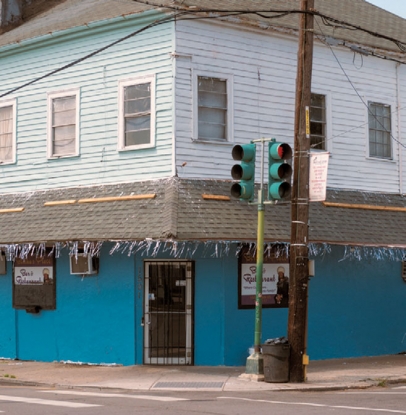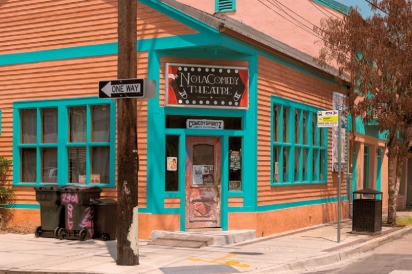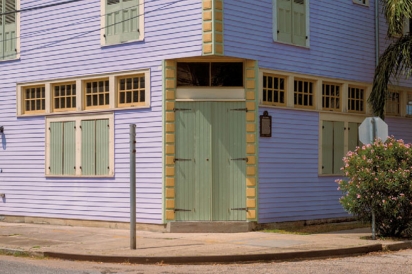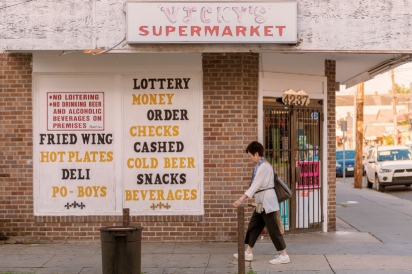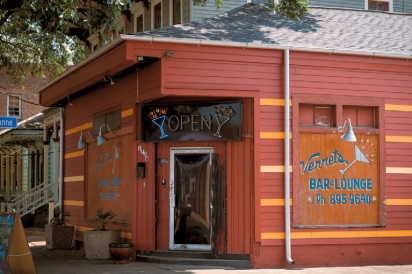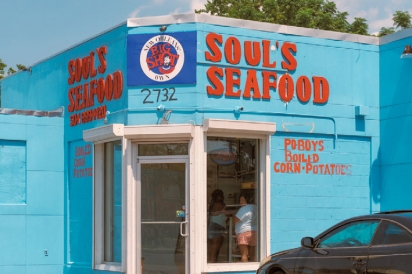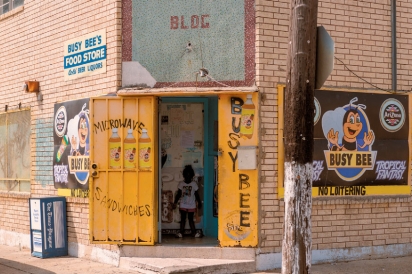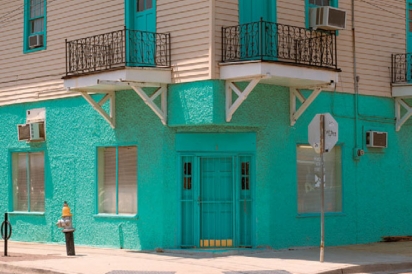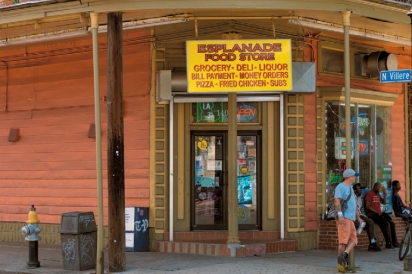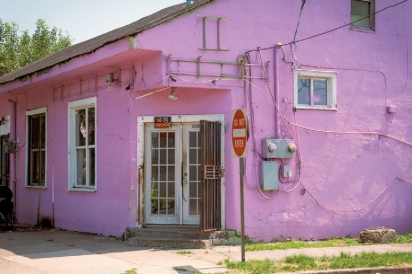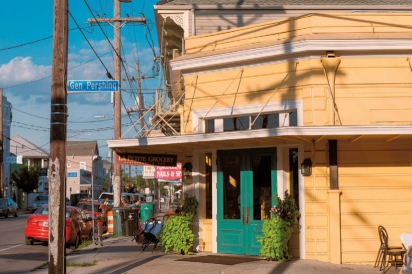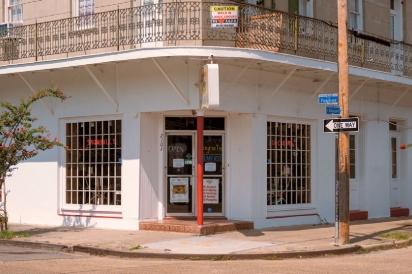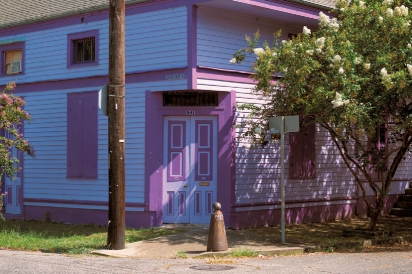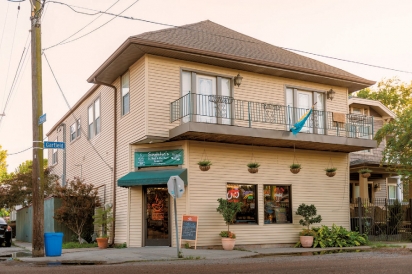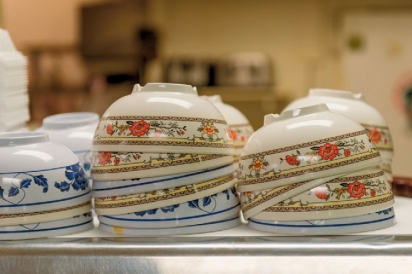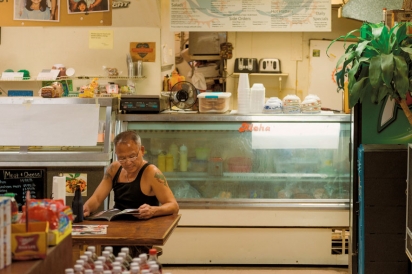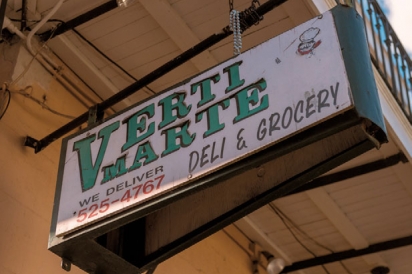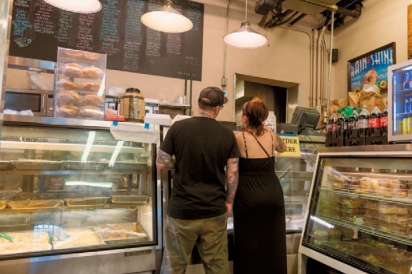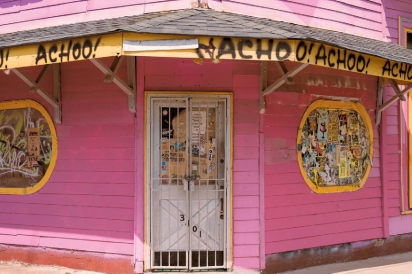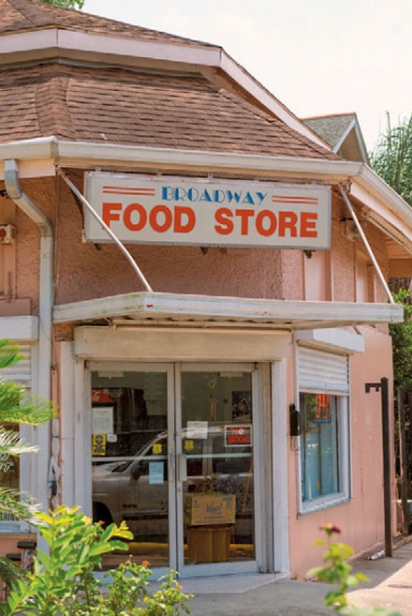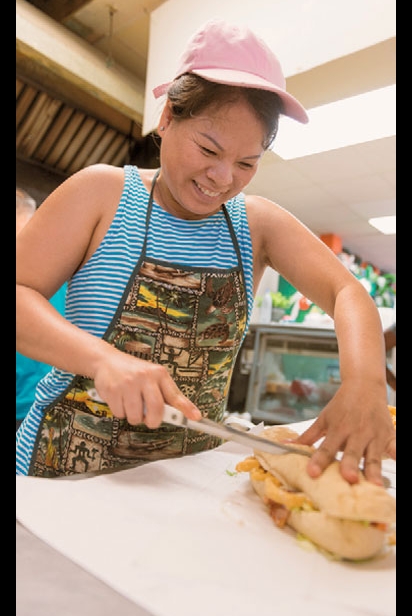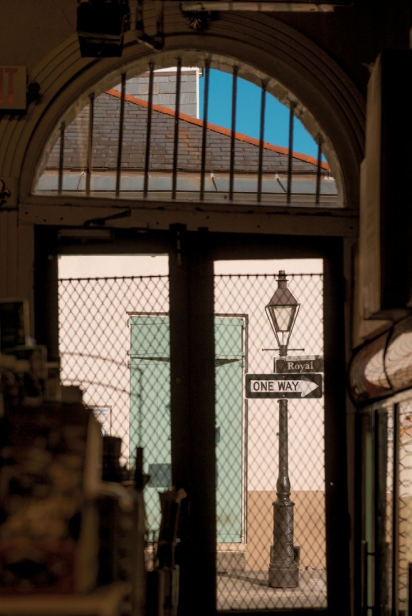Corner Stores: The Storied Past and Uncertain Future of a New Orleans Icon
Down on the Corner
THE STORIED PAST AND UNCERTAIN FUTURE OF A NEW ORLEANS ICON
Fifteen years ago, my husband and I bought a blighted cottage two blocks riverside of Magazine and spent nine tough months salvaging its rotted bones. On the corner of our new block was a store, or what had aspirations of being a store: a bright blue clapboard spot with a hand-painted sign that read Cash n’ Carry. Disappointingly, there wasn’t much for sale inside except off-brand sodas, tall boys, cigarettes and chips. Nor was the owner particularly welcoming to us as newcomers.
Indeed our new neighborhood often struggled to feel like a neighborhood, let alone a desirable one. While modest houses there now fetch well over $400K, it was far from the case then. Our very first night in New Orleans, we lay awake listening to the flat pops of gunshots nearby. In the seven years we lived on that stretch of Laurel, six murders took place within two blocks of our house. We were robbed multiple times.
At first we eyed the Cash n’ Carry with a bit of suspicion—perhaps the store itself invited danger. It had no real food and its clientele, nearly all male, came to drink beer and smoke on the corner or sometimes around a table inside. Eventually our distrust mellowed into a mild dislike of having a beacon of dumpiness on our corner.
Two blocks up on Magazine another corner store, Jennie’s, eventually confirmed my worst fears when, in July 2005, owner Chieu Do was shot to death in her store by an unstable grudge-bearer. Unlike the Cash n’ Carry, my husband and I had been customers at Jennie’s, occasionally stopping in for cheap, carb-driven hot plates before returning to slog away on the house. The store’s slumping overhang and hand-made signs had earned it enough street cred to make the cover shot for The Dirty Dozen’s 1999 album Buck Jump. After the shooting, local writer Jennifer Kuchta would pen a gritty, bald eulogy for the store in her essay “Jennie’s Grocery, RIP.” The essay appeared in the New Orleans anthology Where We Know.
Understandably, Do’s family chose to close the business. After a few changes of ownership, paint jobs and renovation, the building eventually resurfaced as Baru, a hip tapas joint with candlelit tables lining the sidewalk. Within the span of a few years, we watched as numerous buildings in our stretch between Louisiana and Napoleon were sold and renovated, among them corner stores or former stores. Not surprisingly, the Cash n’ Carry was among those that went. The space was gutted and is now a house. In 2004, the white-tablecloth restaurant La Petite Grocery opened several blocks away on Magazine in what was once, as its name suggests, a corner grocery. More recently, another former store and hot plate/wing spot, Monica’s, received a transformative makeover, erasing its aggressively lilac paint to be reborn as the chicly minimalist Vietnamese eatery Magasin.
A Tale of Two Corners
For as long as corner stores have been operating, they’ve been met with mixed, often highly charged views: familiarity and loyalty on the one hand, frustration and complaint on the other. Upon telling a real estate client of mine that I was writing this article, she immediately replied, “I wish I could get rid of the corner store in my neighborhood.” While she adored her new Central City cottage and the area’s diversity, she claimed that one small store had proven a magnet for serious problems. For several minutes, she released a steady stream of complaints, ranging from litter, loitering, drug activity and gunshots to shady owners whom she suspected of illegal activities. Not the least of her issues was the glaring ugliness of the building itself, its barred windows and “crap” merchandise: overpriced junk food, cigarettes, alcohol, with nary a fresh fruit or vegetable in sight. “It just seems to enable the worst instincts,” she said.
But contrast this response with the depiction of another store, also in a transitional neighborhood and one I learned about when I worked as a personal statement coach in a program for under-resourced high school students. When asked to write about a formative experience, one student chose his grandmother’s corner store in the Lower Ninth Ward. He painted a vivid picture: the old timers who kept watch as they played cards from a folding table outside, the swept sidewalks, the bright sign proclaiming his grandmother’s name across the front. The shop had offered a haven from the tough streets surrounding the store. He was proud of the black-owned business whose profits benefitted the community that shopped its shelves. His grandmother hired locals, donated to the nearby school’s sports teams and, because she knew her customers, extended credit to those down on their luck. When the store flooded during Katrina, his grandmother said she was too old to begin again; other family members cited God’s will. The building sat vacant and was eventually razed, leaving only a slab of concrete. Years later, the student’s regret at losing the store remained palpable, and he hoped that with a degree, he could help African Americans to open similar local businesses.
A Vernacular Tradition
“There used to be little groceries operating on almost every corner of our streets. Now only a small fraction of these corner stores remain,” notes Gabrielle Begue, principal at Clio Associates, a local preservation consulting firm who holds a master’s in historic preservation from the Tulane School of Architecture. Like many New Orleanians, Begue is a descendant of a corner store owner. Her great-grandfather, Hippolyte Begue, ran a grocery in the Lower Ninth Ward—now a residence. Begue’s 2012 master’s thesis focused specifically on the architectural roots of corner groceries and the need to preserve their dwindling supply.
Though the number of corner stores has dwindled, Begue’s research reveals that New Orleans was once home to an astonishing number of corner stores. City directories from 1874 show that 40% of the 1,347 registered groceries (it’s likely more existed but operated without licenses) were located on corners. Begue considers 1870—1929 the Golden Age of corner stores, noting factors that enabled them to survive in high numbers, most importantly walkability in a pre-car era and their right to carry the inexpensive dry goods that outdoor markets were expressly prohibited from selling, such as condiments, canned goods and household supplies.
Key to corner store survival was density of population. By 1880, New Orleans’ population had reached some 200,000, with the pumping stations that would allow for the development of Gentilly and the Lakefront still decades away. In packed neighborhoods, these little groceries also held an important social function as crossroads and centers of gossip; storeowners themselves were considered vital sources of local information.
Even so, irate neighbors complained about noise, alcohol, gambling, violence and loitering, concerns which differ little from those voiced today. A cartoon published 1880 in The Daily City Item declared “The exasperated owner of a corner store has put up a sign reading, ‘Wanted, the ten laziest men in town—to loaf on this corner.’” Alcohol-fueled fights, at times fatal, prompted many to oppose the issuing of new licenses. In sum, Begue writes, many New Orleanians came to see corner stores as “havens of vice.” Not surprisingly, when the city’s first comprehensive zoning ordinances were established in 1929, the new regulations sought to phase out these stores from residential areas.
As a historic preservationist, it’s not surprising that Begue’s primary concern for the fate of these buildings is their architectural integrity. And while she encourages their use as commercial spaces, she admits she’d rather see a building remain intact as a residence than torn down or modified to the point of being unrecognizable. For instance, she cites the example of the popular Bywater music bar Vaughn’s, a former German-then Italian-run grocery, and whose minor modifications over the years haven’t obscured the building’s architectural roots. She also points to the much lauded Uptown restaurant La Petite Grocery as a conversion success, with a makeover that’s retained the store’s defining elements, like the lowered entrance that once allowed rolling carts easy access and the diagonal entrance that created visibility in two directions. In addition, Begue notes the restaurant’s clear links to the building’s history both in its choice of name and a website showcasing the building’s long grocery history, first as Mackie’s then Van der Haar’s.
Still, if a corner grocery can no longer fulfill the fundamental real estate maxim of “highest and best use” for these buildings, should we lament their loss? And is wishing for their continued survival, especially as mom and pop stores, anything but hopeless nostalgia for a past that can no longer be?
Shelf Life
Dr. Justin Nystrom, assistant professor of history at Loyola University, has been studying corner stores and interviewing local grocers for years for his book, Creole Italian: How Sicilian Immigrants Shaped the Culture of America’s Most Interesting Food Town, due out from the University of Mississippi Press next summer.
He notes that in the 1930s, advances in refrigeration and transportation spawned a new store model, the supermarket, which gradually edged out smaller corner markets. Foot traffic became less important as residents began to drive to larger stores that, able to buy in bulk, offered cheaper prices and wider selection. By the 1940s, an appealing new concept had appeared: self-service. No longer were customers required to wait for shopkeepers to pull goods from the shelf but were free to peruse at their leisure, pushing carts through clean, cool aisles. In the 1980s, even tougher competition set in with a shift known as “containerization,” resulting in higher costs for any business unable to afford to buy (or house) a shipping container’s worth of goods. The end game? Nystrom notes that most corner groceries that survive today don’t actually sell groceries, instead relying on a few key items, all ripe for abuse: alcohol, cigarettes, soda, chips and lotto tickets.
Nystrom explains another important factor in the former success of corner stores: the tightness of the immigrant family. Once ruled by strict patriarchs and matriarchs, most corner stores employed family members. Begue likewise points to key economies of scale that attracted newly arrived Italian, German and Irish immigrants at the turn of the century: a single building could serve as both business and home as well as supply basic needs, most importantly food, at a discount.
However, the very model that allowed so many corner stores to flourish also contained its eventual undoing, as the American-born sons and daughters of these hardworking entrepreneurs went to college and dreamt of futures away from the counter. With no one to take over the businesses, many aging owners sold.
Take for example, Singleton’s Mini Mart in the Black Pearl, where I stop in specifically in the hopes of finding a thriving corner grocery. What I find is indeed a well-kept building, complete with hanging ferns, flowering pots, a tasteful paint job and architecture that echoes the surrounding cottages. Inside a few basic items and household goods, including some Asian basics, line the shelves next to the usual suspects: chips, soda, candy, cigarettes, beer.
But most happening is the back counter where each Saturday the Nguyen family serves up house-made Vietnamese specialties, like pho, eggrolls and a hearty hangover cure, Shake and Beef, made with tasty slices of tender flank grilled and served with homemade fried eggrolls, fried eggs, rice and salad and fish sauce. While some customers take to-go bags, a long table and stools encourage others to linger over empty plates, sipping beers and chattering away. It’s a visibly diverse crowd, some whom owner Laura Nguyen knows by name and razzes for having been away too long.
“Saturdays used to be our slow day,” her husband Bau says. “Then I start looking at other places to see what they’re doing. Here’s what I learn: If you want to succeed, you have to serve food. Good food.” Now Saturdays are the store’s busiest day with most of the Vietnamese menu selling out by early afternoon. Bau also mentions his “Uptown Thursdays,” longstanding poker and beer sessions that pull in regulars.
The Nguyens purchased Singleton’s in 1999, after having lost their lease on an earlier corner market on Elysian Fields. According to Bau, the Uptown pocket was then “very rough. It’s why we could get the building for cheap.” He points at the light-filled display windows. “The windows weren’t uncovered then.” At the time, four other groceries occupied the surrounding corners; now only Singleton’s remains. Among their newer neighbors are doctors and executives.
Despite the store’s success (and much to my chagrin), Singleton’s is for sale. The four daughters and one son raised upstairs and who have all dished out countless Philly steak and Korean barbecue po-boys, now have college and graduate degrees and are headed for high-earning professions. By any standard, Singleton’s has helped the Bau and Laura, both born in Vietnam, to attain the American dream. Just as importantly, the store has helped anchor a once-struggling neighborhood. “My neighbors, they don’t want to see me go,” Bau says. “But man, I’m tired. Fourteen-hour days.”
Checkout
So is it possible for corner stores to survive? Is it even desirable that they do?
Both our historical experts, Begue and Nystrom, are quick to agree that as institutions, corner groceries are worth saving—not only for the sake of tradition but also because for the sense of community well-run stores create and that modern shoppers still crave. For Begue, the buildings’ versatility as residence, store, restaurant, bar or specialty shop may prove their physical salvation.
But the question of the buildings serving as actual groceries remains tenuous. “Corner groceries probably need to become more of a destination,” she explains, offering Verti Mart with its hot plates and eclectic Mardi Gras Zone in the Marigny, as models. “They need to offer something that sets them apart.” For his part, Nystrom hesitates. It’s an issue he’s explored many times in the course of his interviews with small-scale grocers. “Usually there’s a long silence after this question,” he admits. “It’s a tough, tough business,” he says, even for those who succeed. “There’s no secret to their success. They never go on vacation. They work all the time.”
Nystrom agrees with the need for an “it” factor, citing Nor Joe’s Import Co. in Old Metairie as an example. The old-school Italian market maintains a tight focus on specialty products like cured meats, olive oils, pastas and a muffaletta many claim to be the best around. He also points to the Central City butcher Cleaver and Co., whose locally, sustainably and naturally raised meats appeal to conscientious carnivores and which, Nystrom predicts, represents the type of niche market that can survive the upscaling New Orleans is now experiencing. “What we have is a nostalgia for craft,” he says. “Corner grocery stores used to deliver oysters on the half shell to your door. Do I want that back? Yes.”
Ironically, he notes, Von Der Haar’s Fine Foods, the grocery that once occupied La Petite Grocery, is the kind of corner store that might work today. Citing the store’s reputation for excellent customer service and upscale selection, the small grocery once survived despite being just one block from the self-service giant A & P. Like Singleton’s, Von Der Haar’s closed not because business failed but because the next generation had other plans.
Meet You on the Corner
When I first began writing this article, I expected to end with a pithy plea to preserve the every corner grocery. But I’ve learned that’s not possible. Like so much about this city, the dynamics of corner stores are long, complicated and not so easy to pigeonhole. Some stores have indeed been magnets for crime or targets themselves of violent crime; others, like Singleton’s, have served as cornerstones, when owners doubly invested in neighborhoods as both businesses proprietors and as residents.
In New Orleans, we rightly take great pride in what makes our city remarkable, among these our historic buildings, defined neighborhoods, small independent businesses and our unapologetic love of food. Corner stores have the potential to be guardians of all these qualities. Indeed, for much of their long history, they’ve been exactly that. However, too many corner groceries are in need of serious overhaul. That overhaul need not always be precious; if we are to keep these buildings open to as many as possible, it shouldn’t be. But neither should these spaces be forlorn and tortured-looking, and those that continue to push only our worst impulses should expect more tension as neighborhood values increase. Most, I predict, will eventually fold.
At a minimum, these buildings represent a significant segment of our city’s vernacular architecture, worthy of historically sensitive preservation. Beyond the structural, corner groceries and food markets remain worthy endeavors. In an age when many of us claim to want to walk more, bike more and patronize independent establishments, we should reconsider zoning that prohibits businesses within residential areas or knee-jerk reactions against commercial ventures nearby.
Ironically, the need for pocket stores became clear one sweltering July afternoon when, in an effort to research this piece, my husband and I attempted to drive to several corner groceries across the city. Increasingly irritated at the endless road construction, potholes, traffic and a new Costco lane that forced us to turn away from our intended direction, I blurted out, “This is exactly why I want corner stores!” At times, corner stores may seem raffish and limited, but they offer what the big boxes never will: personality, approachable scale, sociability, the chance to eat an inexpensive made-from-scratch meal or cull the simple ingredients for our own, all without having to compete for parking or cross a scalding cement lot.
Once home in our Carrollton neighborhood, we hoofed it to nearby Jake’s and were pleasantly reminded of their exceptional meat counter and beer selection. Sucked into the supermarket model for so long, we’d simply forgotten what waited a short stroll away.


